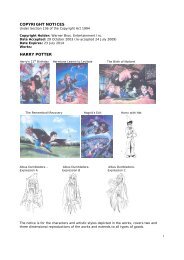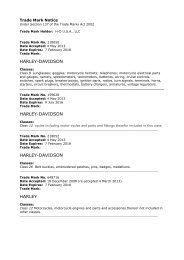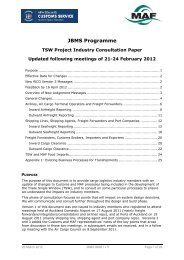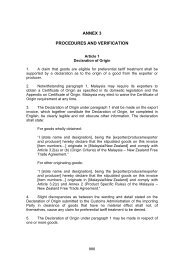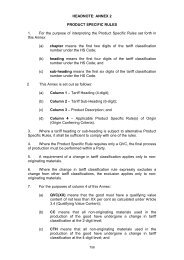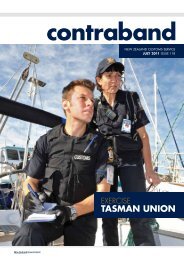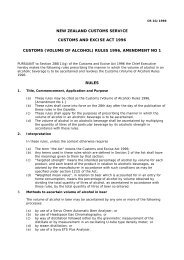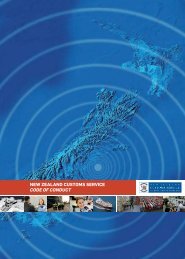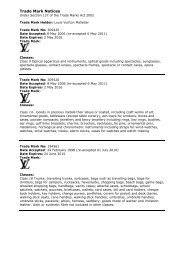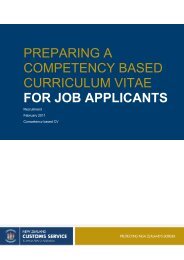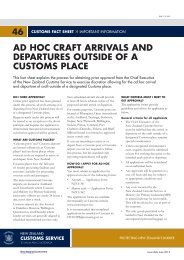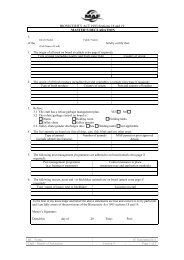New Zealand Customs Service Time Release Study 2010
New Zealand Customs Service Time Release Study 2010
New Zealand Customs Service Time Release Study 2010
Create successful ePaper yourself
Turn your PDF publications into a flip-book with our unique Google optimized e-Paper software.
NEW ZEALANDCUSTOMS SERVICETIME RELEASE STUDY <strong>2010</strong>
2 <strong>Time</strong> <strong>Release</strong> <strong>Study</strong> <strong>2010</strong>
NEW ZEALANDCUSTOMS SERVICETIME RELEASE STUDY <strong>2010</strong><strong>New</strong> <strong>Zealand</strong> <strong>Customs</strong> <strong>Service</strong> 1
ACKNOWLEDGEMENTSThe TRS project team would like tothank all those who contributed to thestudy and in particular acknowledgethe following:Ports of Auckland, AucklandPort of Tauranga, TaurangaPort of Napier, NapierPort Taranaki, <strong>New</strong> PlymouthCentrePort, WellingtonSharon Lin, Operations AnalystPort Nelson, NelsonLyttelton Port Company, ChristchurchPrimePort Timaru, TimaruPort Otago, DunedinSouth Port NZ, BluffDISCLAIMERWhile every effort has been madeto ensure the information in thispublication is accurate, the <strong>New</strong><strong>Zealand</strong> <strong>Customs</strong> <strong>Service</strong> does notaccept any responsibility or liability forerror of fact, omission, interpretation,or opinion that may be present, norfor the consequences of any decisionsbased on this information. Anyview or opinion expressed does notnecessarily represent the view of the<strong>New</strong> <strong>Zealand</strong> <strong>Customs</strong> <strong>Service</strong>.While the <strong>New</strong> <strong>Zealand</strong> <strong>Customs</strong><strong>Service</strong> has exercised all reasonableskill and care in the preparation ofinformation in this report, it does notaccept any liability in contract, tortor otherwise for any loss, damage,injury, or expense, whether direct,indirect or consequential, arising outof the provision of information inthis report.ADDITIONAL COPIES, FEEDBACK AND CONTACT DETAILSYou can download this publicationfrom www.customs.govt.nzIf you wish to provide feedback,information and views that couldbe useful to this publication, pleasecontact:Manager, Operations Strategyand Support<strong>New</strong> <strong>Zealand</strong> <strong>Customs</strong> <strong>Service</strong>PO Box 2218Wellington 6140<strong>New</strong> <strong>Zealand</strong>2<strong>Time</strong> <strong>Release</strong> <strong>Study</strong> <strong>2010</strong>
TABLE OF CONTENTSEXECUTIVE SUMMARY ............................................................................. 4Purpose of the <strong>2010</strong> study ............................................................................... 4Comparison of key results from <strong>2010</strong> and 2009 ............................................ 4Key findings from the <strong>2010</strong> study ................................................................... 5Opportunities for improvement ...................................................................... 6SECTION ONE ........................................................................................... 7Introduction and purpose ................................................................................ 7Objectives and contribution ............................................................................. 7Methodology and scope ................................................................................... 7SECTION TWO .......................................................................................... 8Analysis of sea cargo ........................................................................................ 8Imports ........................................................................................................... 8Exports ......................................................................................................... 10SES analysis .................................................................................................. 12SECTION THREE ......................................................................................13Analysis of air cargo ....................................................................................... 13Imports ......................................................................................................... 13Exports ......................................................................................................... 14SECTION FOUR .......................................................................................15Findings and opportunities ............................................................................ 15Key findings from the study .......................................................................... 15Opportunities for improvement .................................................................... 16SECTION FIVE .........................................................................................17Conclusion ....................................................................................................... 17APPENDICES ...........................................................................................18Appendix A: Scope of project ....................................................................... 18Appendix B: Definitions, glossary, and exclusions ....................................... 19Appendix C: Vessel and aircraft details ......................................................... 21Appendix D: Entry lodgement day ................................................................ 22Appendix E: Containerised cargo charts ....................................................... 23<strong>New</strong> <strong>Zealand</strong> <strong>Customs</strong> <strong>Service</strong> 3
EXECUTIVE SUMMARYPURPOSE OF THE <strong>2010</strong> STUDYThis document reports on the <strong>2010</strong> <strong>Time</strong> <strong>Release</strong> <strong>Study</strong> (TRS). The purpose of that study is to measurethe time it takes the <strong>New</strong> <strong>Zealand</strong> <strong>Customs</strong> <strong>Service</strong> (<strong>Customs</strong>) to clear cargo at the border.The main message from the study isthat <strong>Customs</strong> maintains a high levelof performance in trade facilitation.<strong>Customs</strong> does this by processing,assessing, and clearing legitimatecargo efficiently, early, and fast asconfirmed by the study’s findings andresults.The <strong>2010</strong> TRS is the second suchstudy undertaken by <strong>Customs</strong>, andfollows the 2009 study. The sampleweek was from 24 to 30 September<strong>2010</strong>. The objectives of the <strong>2010</strong>study were to replicate the 2009 studyto produce comparable measurementsand identify opportunities forimprovement.COMPARISON OF KEY RESULTS FROM <strong>2010</strong> AND 2009<strong>Customs</strong> performance in clearing cargo in <strong>2010</strong> remains at similar levels to that found in 2009. As youwould expect there have been changes in the times and percentages of the intervals and events measuredwhen compared to the 2009 baseline measures. Some improved and others declined.COMPARISON OF KEY MEASUREMENTS (DAYS)IMPORT Sea <strong>2010</strong> Sea 2009 Air <strong>2010</strong> Air 2009Arrival to release -1.8 -1.8 Arrival to release 0.6 0.3Arrival to clear n/a -0.8 Arrival to clear n/a 0.3Arrival to gate-out 2.6 2.8 Arrival to availability 0.1 n/k% released before arrival 74 75 % released before arrival 49 59EXPORT Sea <strong>2010</strong> Sea 2009 Air <strong>2010</strong> Air 2009Receipt to lodge 0.8 1.5 Receipt to lodge -0.9 n/kClear to load -4.5 -4.4 Clear to depart -1.2 -1.0% cleared > 48 hrs before loading 85 81 % cleared > 9 hrs before departure 70 714 <strong>Time</strong> <strong>Release</strong> <strong>Study</strong> <strong>2010</strong>
KEY FINDINGS FROM THE <strong>2010</strong> STUDYThe <strong>2010</strong> TRS measures are comparable to the 2009 measures. For many of the key measures thedifferences are minor, with none standing out as showing major changes in performance between the twostudies. Changes observed may be a one-off (specific to the sample week) and the sustainability of anychange will only be confirmed if found to continue in future studies. Overall, although some measuresdeclined there has been an improvement in many of the key measures providing evidence to support<strong>Customs</strong>’ role in facilitating trade.The findings from the <strong>2010</strong> studyreinforce the findings from the 2009study. They are:» <strong>Customs</strong> is efficient in clearingcargo at the border and does notimpede trade un-necessarily. Thelevel of advanced or early reportingfor imports by sea remains highwith a high percentage of cargocleared for release by <strong>Customs</strong>before arrival. There are benefitsto <strong>Customs</strong> and traders fromcompleting <strong>Customs</strong> clearancerequirements early. <strong>Customs</strong>’ earlyreceipt of the required documentsfor assessing and processing releaseof cargo provides more time andcertainty, benefiting both <strong>Customs</strong>and traders.» Export reporting and clearancemeasures for sea cargo haveimproved. Reporting as soon asthe cargo enters <strong>Customs</strong>’ controlprovides time for <strong>Customs</strong> toassess and process the informationand take any action, so as notto impede the cargo before it isloaded.» The analysis of export fullcontainer load (FCLs) showsbenefits to exporters who areSecure Exports Scheme (SES)partners. However, there has beena decrease in the percentage ofFCLs exported by SES partnersfrom 41 percent to 36 percent.In particular FCLs exported tothe United States of America(USA) increased in number, butthe percentage exported by SESexporters declined.» Unlike sea cargo, air cargo isreported later — after arrival.In <strong>2010</strong>, the reporting time andpercentage of entries lodgedbefore arrival decreasedcompared to 2009.» Trade with Australia has increased— an increase of 527 containersfor the week. Reporting forimports was later (decline) butoverall cargo was delivered fasterand times for the export cargomeasures remain similar.» Trade with the People’s Republicof China increased in volumeand there were improvementsin times for many of the eventsmeasured. There was a net gainof 104 export FCLs. Reportingfor imports improved by 0.5 daysbefore arrival, and export reportingwas closer to receipt, giving<strong>Customs</strong> more time to assess theconsignment before arrival andbefore loading.<strong>New</strong> <strong>Zealand</strong> <strong>Customs</strong> <strong>Service</strong> 5
OPPORTUNITIES FOR IMPROVEMENTOpportunities for improvement were identified. These opportunities reinforce the opportunitiesidentified in the 2009 study. <strong>Customs</strong> should continue to work on the opportunities from this yearand last year.» Some cargo types showed animprovement in earlier reportingtimes. <strong>Customs</strong> should continueto work with and encourageindustry to report early to increasethe percentage of entries lodgedbefore arrival. Advanced reportingprovides benefits to traders and<strong>Customs</strong>.» The pattern for air cargo is toreport after arrival. Legislationallows import entries for air cargoto be lodged 24 hours beforearrival. There is opportunityfor <strong>Customs</strong> to work with, andencourage the air cargo industryto lodge earlier, increasing thepercentage of entries lodged andreleased before arrival, and thetime lodged before arrival.» SES contributes to the facilitationof trade by providing a high levelof security and safety of exports.<strong>Customs</strong> should continue topromote the scheme to exportersto increase the number of SESexporters and coverage of FCLsexported.» <strong>Customs</strong> should share theresults of the study with othergovernment agencies and industry.This will promote the role of<strong>Customs</strong> in facilitating trade, and<strong>Customs</strong>’ role in supportingand contributing to growing the<strong>New</strong> <strong>Zealand</strong> economy.6 <strong>Time</strong> <strong>Release</strong> <strong>Study</strong> <strong>2010</strong>
SECTION ONEINTRODUCTIONAND PURPOSEOBJECTIVES ANDCONTRIBUTIONMETHODOLOGYAND SCOPEThe purpose of this report is toreport on the <strong>2010</strong> <strong>Time</strong> <strong>Release</strong><strong>Study</strong> (TRS). The main messagefrom the study is that the <strong>New</strong><strong>Zealand</strong> <strong>Customs</strong> <strong>Service</strong> (<strong>Customs</strong>)maintains a high level of performancein facilitating trade at the border.<strong>Customs</strong> does this by clearinglegitimate cargo from the controlof <strong>Customs</strong> efficiently, early, andfast as confirmed by the study’sfindings and results.The <strong>2010</strong> TRS is the second timerelease study undertaken by <strong>Customs</strong>,and follows the 2009 study. Thissecond study enables comparativeanalysis between the years, reportson changes in the measurementsand identified opportunities forimprovement.The <strong>2010</strong> study followed the World<strong>Customs</strong> Organization (WCO) TRSguidelines and the primary TRSmeasure is defined as:The arithmetic mean between the arrival ofthe goods and their release into the economyvia a standardised system.The <strong>2010</strong> TRS contributes to severalobjectives. The study supports theGovernment’s over-arching goal ofgrowing the economy. It does this byresearching <strong>Customs</strong>’ performance infacilitating international trade acrossthe border.The TRS appears in the <strong>Customs</strong>Annual Plan for <strong>2010</strong> – 2013 andalso supports one of the prioritiesagreed with the Prime Minister andMinister of <strong>Customs</strong> to ‘Enhanceborder agency coordination toreduce duplication and improve theexperience for traders and travellers’that appears in the Statement ofIntent <strong>2010</strong> – 2013. It does this byidentifying opportunities to improveservice delivery that improve theexperience of traders.The objectives of the <strong>2010</strong> study are:» to replicate the 2009 studyand produce comparablemeasurements» to compare the year-on-yearresults to show any changes overtime» to identify opportunities toimprove performance.The study followed the methodologyapplied to the 2009 study. However,this year’s TRS will not involve abilateral study and is a <strong>Customs</strong> onlystudy. The sample week was the sameseven-day period as studied in 2009from 24 to 30 September <strong>2010</strong>.The study was based on import andexport cargo that was unloaded andloaded during the week by sea andair. By replicating the 2009 study, thisenabled the same key intervals to bemeasured to produce evidence of anyyear-on-year change in performance.Additionally, lessons learnt from the2009 TRS were applied to the <strong>2010</strong>study.This report should be read inconjunction with the 2009 reportwhich provides detailed informationregarding the methodology, scope,design, definitions of key events, andintervals measured (also see AppendixA and B).<strong>New</strong> <strong>Zealand</strong> <strong>Customs</strong> <strong>Service</strong> 7
SECTION TWOANALYSIS OF SEA CARGOAccording to Statistics <strong>New</strong> <strong>Zealand</strong>,international cargo to the valueof $70.9 billion was imported andexported through <strong>New</strong> <strong>Zealand</strong> seaports during the <strong>2010</strong> calendar year.This represents 82 percent of the totalvalue of overseas cargo.The number of vessels and portcalls remain similar to the last study(see Appendix C). A total of 59vessels made 96 port calls during theTRS week to unload and load cargocompared to 58 vessels and 102 portcalls in 2009. The differences are mostlikely a function of the timing ofvessels’ arrival time. 1Container volumes increased by 1,308containers. Data on 8,083 export and7,125 import containers was collectedfor the <strong>2010</strong> week compared to 7,934export and 5,966 import containersin 2009. However, in <strong>2010</strong> there weretwo additional container vessels andthree additional port calls during thesample week compared to the 2009week. These additional vessels andcalls could explain the increase incontainer volumes.IMPORTSTABLE 2.1: STATISTICS BY CARGO TYPE (DAYS)Event Overall FCLs LCLs Break-bulk Bulk<strong>2010</strong> 2009 <strong>2010</strong> 2009 <strong>2010</strong> 2009 <strong>2010</strong> 2009 <strong>2010</strong> 2009Arrival to lodge -1.9 -2.0 -2.6 -2.4 -0.7 -0.9 -3.8 -2.6 -4.8 -2.2Arrival to release -1.8 -1.8 -2.4 -2.2 -0.5 -0.8 -3.6 -2.5 -4.8 -2.2Arrival to clear n/a -0.8 n/a -1.1 n/a -0.8 n/a 0.4 n/a 6.6Arrival to availability 0.6 0.5 0.6 0.5 0.6 0.5 n/a n/a n/a n/aAvailability to gate-out 2.0 2.3 2.1 2.2 1.7 3.4 n/a n/a n/a n/aNOTES (FOR ALL TABLES):1. All times are average and measured in days or part of a day unless stated otherwise2. Days are rounded to one decimal place3. Clearance times for other government agencies (OGAs) not available in <strong>2010</strong>4. Gold indicates the same or improved time compared to the 2009 study5. FCL = Full container load6. LCL = Less than container loadTABLE 2.2: STATUS BY CARGO TYPE (%)Event Overall FCLs LCLs Break-bulk Bulk<strong>2010</strong> 2009 <strong>2010</strong> 2009 <strong>2010</strong> 2009 <strong>2010</strong> 2009 <strong>2010</strong> 2009% of entries 100 100 60 48 37 39.5 3 12 0.2 0.5% lodged before arrival 76 78 85 83 61 64 90 84 71 94% released before arrival 74 75 82 80 59 63 89 83 71 94% cleared before arrival n/a 70 n/a 71 n/a 63 n/a 80 n/a 15% released before availability 79 82 86 87 67 72 n/k n/k n/k n/k% cleared before availability n/a 75 n/a 77 n/a 72 n/k n/k n/k n/k1 Changes to shipping lines schedules, port calls and vessel size from 2009 to <strong>2010</strong> were not researched but could be factors that explain the change.8 <strong>Time</strong> <strong>Release</strong> <strong>Study</strong> <strong>2010</strong>
Pre-arrival reporting by industry isat similar levels to the 2009 figures.In <strong>2010</strong>, 76 percent of entries werereported (lodged) before arrivalcompared to 78 percent, while entriesreleased before arrival remain similarat 74 percent versus 75 percent. Thelodgement time of entries beforearrival was 0.1 day later (or closer toarrival, a decline) however the averagerelease time remains the same at 1.8days before arrival. The closenessof the figures makes it difficultto evaluate whether any real andsustained change in performance hasoccurred. Overall: In <strong>2010</strong>, 2 percentfewer entries were lodged beforearrival and were 0.1 day later, but atarrival the release measures are almostthe same at 1.8 days and 74 percentversus 1.8 days and 75 percent in2009.The rounded average (mean) time ittakes <strong>Customs</strong> to assess and process(from lodgement to release) an entryonce accepted by CusMod remainedthe same at 0.2 days. The actualdifference between the average (mean)time <strong>Customs</strong> assesses and processesentries was 1 minute 52 secondslonger in <strong>2010</strong> compared to 2009.While the median time in <strong>2010</strong> wasseven seconds with 87 percent ofentries cleared in less than one minutea decline from 92 percent in 2009.Full container loads (FCLs) remainthe most reliable unit for comparisonto identify change. That is comparedto other cargo types: Less thancontainer load (LCL), break-bulkand bulk where differences arehighly variable in port procedures,commodity, volume, quantity,voyage scheduling and vessel sizemake comparisons less reliableand more difficult to explain anychanges. Whereas the processing andmovement of FCLs along the supplychain is relatively standard.TABLE 2.3: FCL COMPARISON BY PORT OF DISCHARGE RANKED BY ARRIVAL TO RELEASE (DAYS)Port Cntr vessels calls Arrival to lodge Arrival to release Rank<strong>2010</strong> 2009 <strong>2010</strong> 2009 <strong>2010</strong> 2009 <strong>2010</strong> 2009Overall 45 42 -2.6 -2.4 -2.4 -2.2<strong>New</strong> Plymouth 2 2 -4.8 -3.5 -4.8 -2.9 1 5Napier 3 4 -4.2 -3.2 -4.1 -3.1 2 4Otago 4 4 -3.5 -1.9 -3.1 -1.5 3 10Timaru 1 2 -3.0 -3.2 -3.0 -3.2 4 3Wellington 5 3 -2.9 -2.1 -2.7 -2.0 5 8Tauranga 7 7 -2.6 -1.9 -2.4 -1.8 6 9Auckland 14 12 -2.5 -2.3 -2.3 -2.1 7 7Lyttelton 5 4 -2.5 -3.6 -2.2 -3.2 8 2Nelson 2 2 -2.1 -3.6 -1.8 -3.4 9 1Bluff 2 2 -1.3 -3.6 -1.3 -2.4 10 6In <strong>2010</strong>, entries for FCL containerswere on average lodged and releasedby <strong>Customs</strong> 0.2 days (4.8 hours) earlierthan in 2009 — an improvement.The average time for <strong>Customs</strong> toassess and process entries for importFCLs took 0.2 days (the same time in2009) with <strong>Customs</strong> release occurring2.4 days in advance of arrival. Inaddition, the percentage of FCLsreleased before arrival by <strong>Customs</strong>increased by 2 percent to 82 percent.At all ports FCLs received clearancebefore arrival of the vessel carryingthat cargo ranging from 4.8 days for<strong>New</strong> Plymouth to 1.3 days for Bluff.Six ports saw an improvement in therelease time before arrival with fourports showing a decline from the 2009figures.<strong>Time</strong>s have not changed significantlyfor unloading and dwell time. In <strong>2010</strong>unloading was longer by 0.1 days (2.4hours) and the dwell time shorter by0.1 days. Overall, the time betweenarrival and gate-out remained the sameat 2.7 days.The time of unloading is dependenton the vessel’s arrival time which canvary from the scheduled arrival time.As most ports operate 24 hours a dayunloading would commence soon afterthe arrival of the vessel. However,the delivery or gate-out time occursmainly during day light hours the sametrend observed in the 2009 study (seeAppendix E).<strong>New</strong> <strong>Zealand</strong> <strong>Customs</strong> <strong>Service</strong> 9
TABLE 2.4: COUNTRY COMPARISON FOR FCLS RANKED BY ARRIVAL TO RELEASE (DAYS)Country of port of loading Entries FCLsArrival to release Arrival to unload Unload to gate-out<strong>2010</strong> 2009 <strong>2010</strong> 2009 <strong>2010</strong> 2009Overall 4,258 6,654 -2.4 -2.2 0.6 0.5 2.1 2.2Thailand (FTA) 148 210 -4.0 -3.1 0.7 0.7 1.9 2.0Singapore (FTA) 457 607 -2.9 -2.5 0.7 0.5 1.9 1.8Korea, Republic of 157 262 -2.8 -2.4 0.9 0.5 2.3 2.2Japan (MRA) 83 139 -2.7 -2.7 0.7 0.5 2.6 2.0China, People’s Republic of (FTA) 1,102 1,367 -2.2 -1.7 0.7 0.5 2.0 2.0Australia (CER) 986 1,975 -2.1 -2.3 0.4 0.4 2.2 2.5USA (MRA) 187 293 -1.9 -2.2 0.4 0.3 1.8 2.6UK 53 56 -1.0 -1.6 0.6 0.4 1.8 2.1Overseas country of loadingport for import FCLs shows anoverall improvement. There was animprovement in the release time forfive of the eight countries of loadingreported. FCLs from Australia,<strong>New</strong> <strong>Zealand</strong>’s main trading partner,increased by almost 40 percentand entry numbers increased by 33percent. Reporting for imports fromAustralia was later this year by 0.2 daysand later compared to the average, buton average clearance was still receivedbefore arrival. At arrival 82 percent ofFCLs had been released by <strong>Customs</strong>compared to 85 percent in 2009 — adecline. Unloading time remained thesame and the dwell time decreased by0.3 days. The overall time from lodgeto gate-out time for FCLs importedfrom Australia improved to 4.8 days in<strong>2010</strong> compared to 5.3 days in 2009.There has been an increase in tradewith the People’s Republic of Chinafrom 2009 to <strong>2010</strong>. FCL and entryvolumes increased by 15 percent and16 percent. Entries for import FCLsfrom China were lodged earlier in<strong>2010</strong> at 2.7 days before arrival. Thetime <strong>Customs</strong> assessed and processedthese entries (0.5 days) remained thesame, however, the percentage ofFCLs released before arrival increased4 percent to 78 percent. Unloadingtook slightly longer and the dwell timeat ports remained the same at 2 days.EXPORTSTABLE 2.5: STATISTICS BY CARGO TYPE (DAYS)Event Overall FCLs LCLs Break-bulk Bulk<strong>2010</strong> 2009 <strong>2010</strong> 2009 <strong>2010</strong> 2009 <strong>2010</strong> 2009 <strong>2010</strong> 2009Receipt to lodge 0.8 1.5 1.0 1.9 -2.1 -2.8 n/a n/a n/a n/aReceipt to clear 0.9 1.6 1.0 2.0 -2.1 -2.8 n/a n/a n/a n/aReceipt to load -5.5 -5.9 -5.5 -6.3 -2.6 -2.2 n/a n/a n/a n/aLodge to load – 48 hour rule -4.5 -4.4 -4.6 -4.4 -4.4 -5.1 n/a n/a n/a n/aClear to load -4.5 -4.4 -4.5 -4.4 -4.4 -5.1 n/a n/a n/a n/aClear to departure -5.0 -5.0 -4.9 -4.8 -4.6 -5.4 -7.4 -6.9 -6.3 -8.3TABLE 2.6: STATUS BY CARGO TYPE (%)Event Overall FCLs LCLs Break-bulk Bulk<strong>2010</strong> 2009 <strong>2010</strong> 2009 <strong>2010</strong> 2009 <strong>2010</strong> 2009 <strong>2010</strong> 2009% of entries 100 100 79 71.5 6 11 14 16.5 1 1% cleared before receipt 44 45 43 41 91 90 n/a n/a n/a n/a% lodge > 48 hours before load 85 81 84 81 94 87 n/a n/a n/a n/a10 <strong>Time</strong> <strong>Release</strong> <strong>Study</strong> <strong>2010</strong>
There have been some changesin export reporting by industryin <strong>2010</strong>. Overall there have beenimprovements in the export measuresthis year. Entries were lodged closerto receipt time — the time the cargoenters <strong>Customs</strong>’ control. The key<strong>Customs</strong> measure of lodging andclearing entries 48 hours beforeloading improved by 0.1 day whilethe percentage of entries lodgedmore than 48 hours before loadingimproved. Dwell time decreased by0.4 days — an improvement. Whatthis means is that in <strong>2010</strong> <strong>Customs</strong>was, on average, notified earlier tothe time the cargo enters <strong>Customs</strong>control, providing <strong>Customs</strong> more timeto assess and process the informationbefore a <strong>Customs</strong> Export DeliveryOrder (CEDO) authorising loadingis given and the time the cargo was atthe port was shorter.TABLE 2.7: COUNTRY COMPARISON FOR FCLS RANKED BY CLEAR TO LOAD (DAYS)Country of Discharge Entries FCLS %SESReceipt tolodgeReceipt toclearLodgeto loadClearto loadReceiptto load<strong>2010</strong> 2009 <strong>2010</strong> 2009 <strong>2010</strong> 2009 <strong>2010</strong> 2009 <strong>2010</strong> 2009Overall 3,200 8,057 36 1.0 1.9 1.0 2.0 -4.6 -4.4 -4.6 -4.4 -5.7 -6.3Singapore (FTA) 278 884 85 2.7 2.7 2.7 2.7 -5.8 -5.2 -5.8 -5.2 -8.5 -8.0USA (MRA) 312 482 40 -1.1 1.3 -0.9 1.4 -5.8 -6.1 -5.6 -6.0 -4.7 -7.4Korea, Republic of 128 264 40 -0.3 0.6 -0.3 0.6 -5.0 -4.2 -5.0 -4.1 -4.8 -4.7Japan (MRA) 178 354 33 0.4 1.9 0.4 2.0 -4.7 -4.5 -4.7 -4.5 -5.2 -6.5China, People’s Republicof (FTA)298 1,209 29 0.5 2.5 0.5 2.5 -4.3 -4.0 -4.3 -4.0 -4.8 -6.5UK 67 78 8 0.0 0.0 0.1 0.0 -4.4 -4.5 -4.3 -4.5 -4.4 -4.5Thailand (FTA) 35 137 9 1.4 2.1 1.4 2.1 -4.0 -3.8 -4.0 -3.8 -5.4 -5.9Australia (CER) 729 1,857 21 0.8 0.8 0.8 0.8 -3.8 -3.3 -3.8 -3.3 -4.6 -4.0The reporting of export FCLs bycountry of discharge has improvedfrom 2009. In <strong>2010</strong> <strong>Customs</strong> knowsabout FCL containers and contentsearlier compared to 2009. Thelodgement time for export entries isnearer to receipt or gate-in time at1 day compared to 1.9 days in 2009.The receipt time at the port isimportant because this is the timewhen the container enters a <strong>Customs</strong>port and <strong>Customs</strong>’ control. However,for most cargo it is the lodgementof the entry when <strong>Customs</strong> becomesaware of the cargo and can thenassess, process and, if necessary,plan any intervention.The key measure for <strong>Customs</strong>clearance (Clear to load) to authoriseloading for export improved by0.2 days to 4.6 days before loadingcompared to 4.4 days in 2009. Ahigher percentage of FCLs — 84percent were cleared more than 48hours before loading. The dwell timedeclined 0.6 days or 14 hours. Theexport measures improved overall,reporting is earlier and containersare delivered to the port closer to theloading time.The percentage of FCLs exportedby Secure Export Scheme (SES)exporters has declined from 41percent to 36 percent. There is alsosome volatility at the country ofdischarge level related to the SESmeasures. Only two countries showan increase in the percentage of FCLsexported by SES — Singapore andthe Republic of Korea.An important market for <strong>New</strong><strong>Zealand</strong> exporters, the USA, sawcontainer numbers increase 6 percentbut the percentage of FCLs exportedby SES exporters decline to 40percent from 56 percent. Additionally,there was a large change in thereporting of entries for export FCLsto the USA. Significantly, exporterslodged or declared export entries 1.1days before receipt compared to 1.3days after receipt in 2009 — a majorchange. At receipt, 61 percent ofFCLs had been declared and clearedby <strong>Customs</strong> in <strong>2010</strong> compared to48 percent in 2009 an increase of13 percent which helps to explainthe change in reporting time beforereceipt.<strong>New</strong> <strong>Zealand</strong> <strong>Customs</strong> <strong>Service</strong> 11
Exports FCLs to Australia, <strong>New</strong><strong>Zealand</strong>’s main trading partnerdecreased by 2 percent and thepercentage from SES exportersdeclined by 4 percent. The measuresreceipt to lodge and receipt to clearremain the same in <strong>2010</strong> at 0.8days. At receipt 38 percent of FCLswere declared and cleared in <strong>2010</strong>compared to 41 percent in 2009. Thedwell time for export FCLs increasedby 0.6 days to 4.6 days compared to4.0 days in 2009.At other country of discharge level,the number of FCLs exported toSingapore increased by 39 percentthis, however, could be a result ofshipping lines using Singapore asa hub port. The number of FCLsexported to China increased by 33percent, Japan 20 percent, and theRepublic of Korea 18 percent, whileexports to Thailand increased by 90percent although from a low base.SES ANALYSISTABLE 2.8: SES ANALYSIS FOR FCLsEvent SES Non-SESNo of exporters 74 841No of entries lodged 995 2,205% of FCLs exported 36 64Receipt to lodge 1.8 0.5Receipt to clear 1.8 0.5Receipt to load -7.1 -4.6Lodge to load -5.4 -4.1Clear to load -5.4 -4.1Lodge to clear 17 seconds 55 minutesAround 8 percent of exporters belongto SES and account for 36 percentof all FCLs exported. In <strong>2010</strong>, thepercentage of FCLs exported bySES partners decreased 5 percent.However, the remaining measuresfor <strong>2010</strong> follow the pattern seen in2009. SES exporters are deliveringcontainers to the port earlier thannon-SES, on average 2.5 days earlierbut are lodging export entries later1.8 days after receipt compared to 0.5days for non-SES.<strong>Customs</strong>, on average clears (Lodgeto clear) entries from SES partnersquicker — 17 seconds than entrieslodged by non-SES — 55 minutes.This is similar to the 2009 findingwhere SES entries were on averagecleared in 11 seconds compared to44 minutes for non-SES. On average,<strong>Customs</strong> clearance is given more than48 hours before loading for both SESand non-SES.2 SES is <strong>New</strong> <strong>Zealand</strong>’s equivalent to an Authorized Economic Operator (AEO) programme.12 <strong>Time</strong> <strong>Release</strong> <strong>Study</strong> <strong>2010</strong>
SECTION FOURFINDINGS AND OPPORTUNITIESKEY FINDINGS FROM THE STUDYThe purposes of the <strong>2010</strong> studywere: to replicate the 2009 study; toproduce comparable measures; andto identify areas for improvement.This TRS provides <strong>Customs</strong> witha second set of data and measuresthat allow comparison betweenthe two studies. Differences in themeasurements can therefore explainchanges in performance. For manyof the key measures the differenceswere minor, with none standingout as showing major changes inperformance between the two studies.Changes observed may be one-off(specific only to the sample week) andthe sustainability or continuation ofany change will only be confirmedin future studies. Overall, althoughsome measures declined there hasbeen an improvement in many ofthe measures providing evidencesupporting <strong>Customs</strong>’ role infacilitating trade.Additionally, the findings from the<strong>2010</strong> TRS support the findings fromthe 2009 study. The key findings are:» <strong>Customs</strong> is efficient in clearingcargo at the border and doesnot impede trade un-necessarily.The level of advanced orearly reporting for imports bysea remains high with a highpercentage of cargo released by<strong>Customs</strong> before arrival. The <strong>2010</strong>study shows a slight decline inthe percentage of entries lodgedby traders or their agents beforearrival and lodgement is closer(later) to arrival. However, themeasures for release are similarto 2009. Advanced reportingwas a key finding from the 2009study and the three Australianstudies, to date. There are benefitsto <strong>Customs</strong> and traders fromcompleting <strong>Customs</strong> clearancerequirements early. <strong>Customs</strong>’ earlyreceipt of the required documentsfor assessing and processingrelease of cargo provides moretime and certainty, benefiting both<strong>Customs</strong> and traders.» Export reporting and clearancemeasures for sea cargo haveimproved. Reporting as soon asthe cargo enters <strong>Customs</strong> controlprovides time for <strong>Customs</strong> toassess and process the informationand take any action, so to notimpede the cargo before it isloaded.» The analysis of export FCLsshows benefits to exporterswho are SES partners. However,there has been a decrease in thepercentage of FCLs exported bySES partners from 41 percent to36 percent. In particular FCLsexported to the USA increasedin number but the percentageexported by SES exportersdeclined. Should this patterncontinue then <strong>Customs</strong> may seean increase in requests from theUSA to inspect/x-ray containers toconfirm the cargo is safe to load.» Unlike sea cargo, air cargo isreported later — after arrival.In <strong>2010</strong>, both the reporting timeand percentage of entries lodgedbefore arrival decreased comparedto 2009. The information requiredto complete <strong>Customs</strong>’ reportingrequirements and shorter transportand dwell times are the most likelyexplanations for why air cargo isreported later.» Trade with Australia has increased— an increase of 527 containersfor the week. Reporting forimports was later (decline) butoverall cargo was delivered fasterand times for the export cargomeasures remain similar.» Trade with the People’s Republicof China increased in volume andthere were improvements in timesfor many of the events measured.There was a net gain of 104 exportFCLs. Reporting for importsimproved by 0.5 days before arrivaland export reporting was earlier toreceipt, giving <strong>Customs</strong> more timeto assess the consignment beforearrival and before loading.<strong>New</strong> <strong>Zealand</strong> <strong>Customs</strong> <strong>Service</strong> 15
OPPORTUNITIES FORIMPROVEMENTOpportunities for improvementwere identified. These opportunitiesreinforce the opportunities identifiedfrom the 2009 study. <strong>Customs</strong> shouldcontinue to work on the opportunitiesfrom this year and last year.» Some cargo types showed animprovement in earlier reportingtimes. <strong>Customs</strong> should continue towork with and encourage industryto lodge declarations earlier toincrease the percentage of entrieslodged before arrival. Advancedreporting provides benefits totraders and <strong>Customs</strong>.» The pattern for air cargo is toreport after arrival. Legislationallows entries for air cargo to belodged 24 hours before arrival.However, this year and in 2009entries were on average lodgedafter arrival. The delivery ofair cargo is more time-sensitivecompared to sea so there is anopportunity for <strong>Customs</strong> to workwith and encourage the air cargoindustry to lodge earlier to increasethe percentage of entries lodgedand released before arrival and thetime lodged before arrival.» The percentage of FCLs exportedby SES partners decreased thisyear. SES contributes to thefacilitation of trade by providinga high level of security and safetyover exports. <strong>Customs</strong> shouldcontinue to promote the schemeto increase the number of SESexporters and coverage of FCLsexported.» <strong>Customs</strong> should share theresults of the study with othergovernment agencies and industry.This will promote the role of<strong>Customs</strong> in facilitating trade, and<strong>Customs</strong> role in supporting andcontributing to growing the <strong>New</strong><strong>Zealand</strong> economy.16 <strong>Time</strong> <strong>Release</strong> <strong>Study</strong> <strong>2010</strong>
SECTION FIVECONCLUSIONThe <strong>2010</strong> TRS provides <strong>Customs</strong>with a second set of measuresrelating to the clearance of cargo.This second TRS allows comparativeanalysis between the <strong>2010</strong> and 2009sample weeks. Analysis of differencein the measures identify changesin the performance of <strong>Customs</strong>in clearing cargo at the border. Asexpected some measures improvedand others declined but overallthere were no major changes thatindicate any significant change inperformance. The findings andopportunities identified are similar tothe 2009 study and <strong>Customs</strong> shouldcontinue to work on these.In summary, the measurements showthat <strong>Customs</strong> is efficient and fast inclearing legitimate cargo, supportingthe work <strong>Customs</strong> undertakes tofacilitate trade. The study providesevidence that demonstrates how<strong>Customs</strong> supports the goal ofgovernment to grow the economyof <strong>New</strong> <strong>Zealand</strong> by measuring andreporting on the delivery of serviceto traders engaged in internationaltrade. Future studies will providefurther sets of measures and evidenceof actual and sustainable change inthe way <strong>Customs</strong> manages and worksat the border clearing cargo.<strong>New</strong> <strong>Zealand</strong> <strong>Customs</strong> <strong>Service</strong> 17
APPENDICESAPPENDIX A: SCOPE OF PROJECTTABLE A.1: HIGH LEVEL SCOPEIncludesCarry out research on international cargo – sea and air. International cargo is defined asconsignments declared on an import or export entry that enter or leave the commerce of<strong>New</strong> <strong>Zealand</strong> where the port of discharge or port of loading is a <strong>New</strong> <strong>Zealand</strong> portTo collect the times for the identified events from arrival to gate-out for imports and receipt todeparture for exports from <strong>Customs</strong> records and from industry to measure and calculate thekey and secondary intervals. Containerised cargo being the most important type of cargo tocollect data for and to measure. There will be some analysis of other cargo types – bulk andbreak-bulk and air cargoDoes not includeTransit sea cargoEmpty containersCoastal & feeder cargoLow value consignments cleared by ECIOther government and border agenciesTo report the outcomes and recommendations from the research to the project sponsorand <strong>Customs</strong> senior managementTo report to the MinisterTo publish and report the findings from this studyTo incorporate feedback from the 2009 and <strong>2010</strong> studies into the 2011 TRS18 <strong>Time</strong> <strong>Release</strong> <strong>Study</strong> <strong>2010</strong>
APPENDIX B: DEFINITIONS, GLOSSARY, AND EXCLUSIONSTABLE B.1: KEY EVENT DEFINITIONSEventArrivalLodgement/ declaration<strong>Release</strong> (for imports)ClearanceAvailabilityGate-out (delivery)Gate-in (receipt)LoadDepartureDefinitionThe date and time of the arrival of the means of transport (sea or air) conveying the goodsat importation. For sea cargo arrival, this means the docking time of the vessel at the port ofdischarge. For air cargo arrival, this means the on-blocks time recorded for the aircraft.When a customs declaration or entry is reported and declared to the customs administration,including all relevant and required information to obtain the release of the goods. This is the timestamp recorded when CusMod accepts and writes the information to the database.The time at which <strong>Customs</strong> controls are competed and CusMod clears the entry and a deliveryorder is generated. Note, the goods may remain subject to quarantine controls, shipping line,and port companies holds.The point at which all border agency controls are completed and the consignment is completelyunimpeded. This is the time recorded as final clearance. But may still be subject to holds byshipping lines and port companies. Note: for exports release and clearance are the same time.The time an import consignment becomes physically available for delivery. For sea cargo thistime is equivalent to the unloading time from the vessel. For air cargo this is the time when theconsignment is received from the fl ight.The time recorded by the port company when the container leaves the port gates. Goods stillsubject to <strong>Customs</strong> and other government agencies controls may still be removed from the port toanother CCA or a TF.The point at which goods are delivered to a place of export at the port of export and enterphysical customs control at the <strong>Customs</strong> port or airport. For sea cargo this is time recorded bythe port company when the container is receipted at the port gates. For air cargo it is the timerecorded when the consignment is received from the shipper.The date and time recorded by the port company when the container is physically loaded onboardthe vessel transporting it to an overseas destination.The date and time of the departure of the means of transport (sea or air) conveying the goods atexportation. For sea cargo departure, this means the time that the vessel departs from the port ofloading. For air cargo departure, this means the off-blocks time recorded for the aircraft.<strong>New</strong> <strong>Zealand</strong> <strong>Customs</strong> <strong>Service</strong> 19
TABLE B.2: GLOSSARYAEO Authorized economic operator n/a not applicableCCA <strong>Customs</strong> controlled area n/k not knownCEDO <strong>Customs</strong> export delivery order NZCS <strong>New</strong> <strong>Zealand</strong> <strong>Customs</strong> <strong>Service</strong> Te Mana Ārai o AotearoaCER Closer Economic Relations MAFBNZ Ministry of Agriculture and Forestry Biosecurity <strong>New</strong> <strong>Zealand</strong>CTO Cargo terminal operator MRA Mutual recognition agreementECI Electronic cargo information SES Secure Exports SchemeFCL Full container load TF Transitional facilityFTA Free trade agreement TRS <strong>Time</strong> release studyLCL Less than container load WCO World <strong>Customs</strong> OrganizationTABLE B.3: EXCLUSIONSBunkeringCarnet goodsCoastal cargoDiplomatic goodsEmpty containersExempt goodsFeeder cargoGoods cleared by ECIMailMilitary equipmentPersonal and household effectsShips storesTankers – mineral oilsTranshipmentsTransit cargoesNOTES:1. Imported mineral oils are excluded from the TRS. Shipments of mineral oils were discharged during the TRS week andrepresent the largest dollar value by commodity type imported. These importations are excluded because the shipmentsare entered as periodic entries, not standard import entries. Periodic entries are lodged the following month and cancover several shipment and all ports of discharge.20 <strong>Time</strong> <strong>Release</strong> <strong>Study</strong> <strong>2010</strong>
APPENDIX C: VESSEL AND AIRCRAFT DETAILSTABLE C.1: VESSEL TYPESVessel type <strong>2010</strong> 2009Bulk carrier 21 22Container 20 18Multi-purpose (break-bulk and containers) 9 9Tanker 6 5Car carrier 3 4Total vessels 59 58NOTES:1. Of the bulk carriers, 7 discharged bulk cargoes while 16 loaded bulk cargoes. Logs dominated bulk export cargoeswith 11 of the 16 carriers loading logs for export.TABLE C.2: VESSEL ARRIVALS BY PORT DURING THE TRS WEEKPort <strong>2010</strong> 2009Marsden Point n/a 1Northport 5 3Auckland 21 21Tauranga 14 21Gisborne 2 1Napier 6 6<strong>New</strong> Plymouth 8 9Wellington 11 7Marlborough 2 1Nelson 4 8Lyttelton 12 12Timaru 2 4Port Chalmers 4 6Bluff 5 2Total vessel movements 96 102TABLE C.3: AIRCRAFT MOVEMENTS BY AIRPORT DURING THE TRS WEEKArrivals – carrying cargo <strong>2010</strong> 2009Auckland 321 291Wellington 24 40Christchurch 71 85Total 416 416Departures – carrying cargo <strong>2010</strong> 2009Auckland 288 284Wellington 6 14Christchurch 53 68Total 347 366<strong>New</strong> <strong>Zealand</strong> <strong>Customs</strong> <strong>Service</strong> 21
APPENDIX D: ENTRY LODGEMENT DAYCHART D.1: ENTRY LODGEMENT DAY2,0001,8001,6001,400ImportExportNUMBER1,2001,0008006004002000MondayTuesdayWednsdayThursday Friday SaturdaySundayDAYThis chart shows the day import and export entries were lodged by customs brokers, importers and exporters or theiragents and accepted by CusMod for the TRS data collected. The <strong>2010</strong> pattern is very similar to 2009 — a steady increasein entries lodged from Monday until the end of the week. Again in <strong>2010</strong> Thursday is the busiest day for lodging entrieswith fewer entries are lodged in the weekend like the 2009 study.22 <strong>Time</strong> <strong>Release</strong> <strong>Study</strong> <strong>2010</strong>
APPENDIX E: CONTAINERISED CARGO CHARTSCHART E.1: IMPORT FCLS UNLOAD AND GATE-OUT HOUR600Unload500Gate-out400NUMBER300200100000:00-01:0001:00-02:0002:00-03:0003:00-04:0004:00-05:0005:00-06:0006:00-07:0007:00-08:0008:00-09:0009:00-10:0010:00-11:0011:00-12:0012:00-13:0013:00-14:0014:00-15:0015:00-16:0016:00-17:0017:00-18:0018:00-19:0019:00-20:0020:00-21:0021:00-22:0022:00-23:0023:00-24:00HOURThis chart shows the unloading and gate-out hour for FCLs. Ports operate 24 hours a day, 7 days a week, and containersare unloaded and delivered throughout the day and night. For the <strong>2010</strong> week, there is a busy period from midnightthrough to 10 am when between 300 and 400 containers were unloaded per hour. The unloading hour is a function of thevessel arrival time so will vary from week-to-week and year-to-year. However, the gate-out hour in <strong>2010</strong> follows a similarpattern observed in 2009 where the majority of containers were delivered during day light hours. Between 7 am and 7pm, 75 percent of containers were recorded leaving the ports. To also point out, during the hour 6 am to 7 am, 116 FCLswere delivered, then between the hour 7 am to 8 am, 448 FCLs were delivered — almost a 300 percent increase. For bothstudies, the busiest hour for gate-out was from 10 am to 11 am when 529 FCLs were delivered in <strong>2010</strong>.<strong>New</strong> <strong>Zealand</strong> <strong>Customs</strong> <strong>Service</strong> 23
CHART E.2: EXPORT FCLS GATE-IN AND LOADING HOUR700600Gate-inLoading500NUMBER400300200100000:00-01:0001:00-02:0002:00-03:0003:00-04:0004:00-05:0005:00-06:0006:00-07:0007:00-08:0008:00-09:0009:00-10:0010:00-11:0011:00-12:0012:00-13:0013:00-14:0014:00-15:0015:00-16:0016:00-17:0017:00-18:0018:00-19:0019:00-20:0020:00-21:0021:00-22:0022:00-23:0023:00-24:00HOURThis chart shows the receipt hour (gate-in) and load hour for export FCLs. Containers are delivered to the port andloaded onto vessels throughout the day and night with loading time a function of the vessel’s arrival and departure times.The week of the <strong>2010</strong> study there was a busy period for loading from mid afternoon into the evening, with the busiesthour 2 pm – 3 pm when 659 FCLs were loaded. However, like the gate-out time for import containers, the day lighthours see most export containers delivered to the port. From 7 am to 7 pm, 75 percent of export FCLs were receivedat the port with a busy period from 7 am to mid afternoon and the busiest hour 7 am to 8 am when 634 FCLs weredelivered to the ports.24 <strong>Time</strong> <strong>Release</strong> <strong>Study</strong> <strong>2010</strong>
<strong>New</strong> <strong>Zealand</strong> <strong>Customs</strong> <strong>Service</strong> 25
26 <strong>Time</strong> <strong>Release</strong> <strong>Study</strong> <strong>2010</strong>



